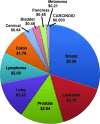Priorities for improving the management of gastroenteropancreatic neuroendocrine tumors
- PMID: 18780869
- PMCID: PMC2538549
- DOI: 10.1093/jnci/djn275
Priorities for improving the management of gastroenteropancreatic neuroendocrine tumors
Abstract
A National Cancer Institute summit meeting on gastroenteropancreatic neuroendocrine and carcinoid tumors was held in September 2007 to present the currently accepted standards of care for patients with these tumors and to identify areas requiring investigation and development. These tumors are clinically and pathologically heterogeneous, present commonly with obscure symptoms that lead to delays in diagnosis of years, and have an incidence in the United States of 2.5 to 5 cases per 100,000. The 5-year survival rates range between 15% and 95%, depending on the site and extent of disease. This report delineates the main conclusions of the meeting, including the best practice diagnosis and treatment strategies for gastropancreatic neuroendocrine tumors, and the identification of clinical and scientific areas that are most in need of attention. The most pressing needs were public and physician education, identification of molecular markers for early diagnosis and therapeutic monitoring, improved imaging modalities and molecular prognostication, development of a standardized pathological classification system, and creation of regional centers of expertise with tumor and laboratory data banks. In addition, adequately validated neuroendocrine tumor models and cell lines should be established to investigate the molecular mechanisms involved in the control of their growth and secretion, and to facilitate the development of specific therapies that should be examined in well-designed multicenter studies of defined patient groups.
Figures


References
-
- Modlin IM, Lye KD, Kidd M. A 5-decade analysis of 13,715 carcinoid tumors. Cancer. 2003;97(4):934–959. - PubMed
-
- Modlin IM, Oberg K, Chung DC, et al. Gastroenteropancreatic neuroendocrine tumours. Lancet Oncol. 2008;9(1):61–72. - PubMed
-
- Modlin IM, Kidd M, Latich I, Zikusoka MN, Shapiro MD. Current status of gastrointestinal carcinoids. Gastroenterology. 2005;128(6):1717–1751. - PubMed
-
- Oberndorfer S. Karzinoide tumoren des dünndarms. Frankf Z Pathol. 1907;1:426–432.
-
- Modlin I, Gustafsson B, Kidd M. Howden CW, Baillie J, Buchman AL, Metz DC, Modlin IM. Advances in digestive disease. Bethesda, MD: AGA Institute Press; 2007. Gastrointestinal carcinoid tumors; pp. 203–220.
Publication types
MeSH terms
Substances
LinkOut - more resources
Full Text Sources
Other Literature Sources
Medical

